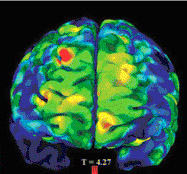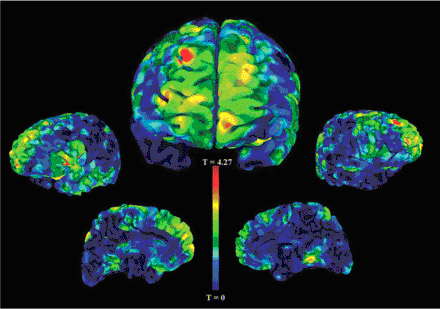Archived Content
The National Institute of Mental Health archives materials that are over 4 years old and no longer being updated. The content on this page is provided for historical reference purposes only and may not reflect current knowledge or information.
Childhood Bedwetting Occurred Twice as Often in Adults with Schizophrenia
• Science Update

Reduced gray matter (red):
vestige of early developmental insult?
Childhood bedwetting occurred twice as often in adults with schizophrenia than in their unaffected brothers and sisters, according to a new study from researchers at NIMH. Their report appears in the September 2008 issue of the journal Brain.
In the study led by NIMH's Thomas M, Hyde, M.D., Ph.D., the mothers of 211 adult schizophrenia patients and of 234 unaffected adult brothers and sisters were asked to recall their children's bedwetting history. For additional comparison, mothers of 355 other adults without schizophrenia were also asked to recall their children's bedwetting.
The researchers found that 21 percent of the schizophrenia patients experienced childhood bedwetting, compared with 11 percent of their unaffected brothers and sisters, and 7 percent of those in the other comparison group. This suggests that childhood bedwetting indicates abnormal brain development that contributes to the development of schizophrenia, the study authors say.
The investigators used psychological tests of academic skills and intellectual ability to look for other features to distinguish between schizophrenia patients with a bedwetting history from patients without. Those with a bedwetting history scored lower on two language fluency tests than patients without a history. Performance on these tests is linked to the function of the front part of the brain, where higher level thinking takes place.
Magnetic resonance imaging (MRI) brain scans revealed that patients with a bedwetting history had reduced gray matter in the front of the brain — which processes information — but the patients without a bedwetting history did not. This part of the brain has been associated with bladder control and with the development of schizophrenia.
Considered together, the study's findings advance the concept that schizophrenia is associated with difficulties during early childhood development, particularly with difficulties in the development of the front part of the brain.
Reference
Hyde TM, Deep-Soboslay A, Iglesias B, Callicott JH, Gold, JM, Meyer-Lindenberg A, Honea RA, Bigelow LB, Egan MF, Emsellem EM, Weinberger DR. Enuresis as a premorbid developmental marker of schizophrenia. Brain, Sept. 2008.

Patients with schizophrenia who had a history of childhood bedwetting showed reduced gray matter (the working tissue of the brain) in the front of the brain, particularly an area near the top on the right side (large red area). The frontal areas are known to be involved in bladder control and have also been implicated in schizophrenia, hinting that the childhood problem and attendant structural anomalies may represent a vestige of an early insult to the developing frontal cortex. Structural and functional MRI image data.
